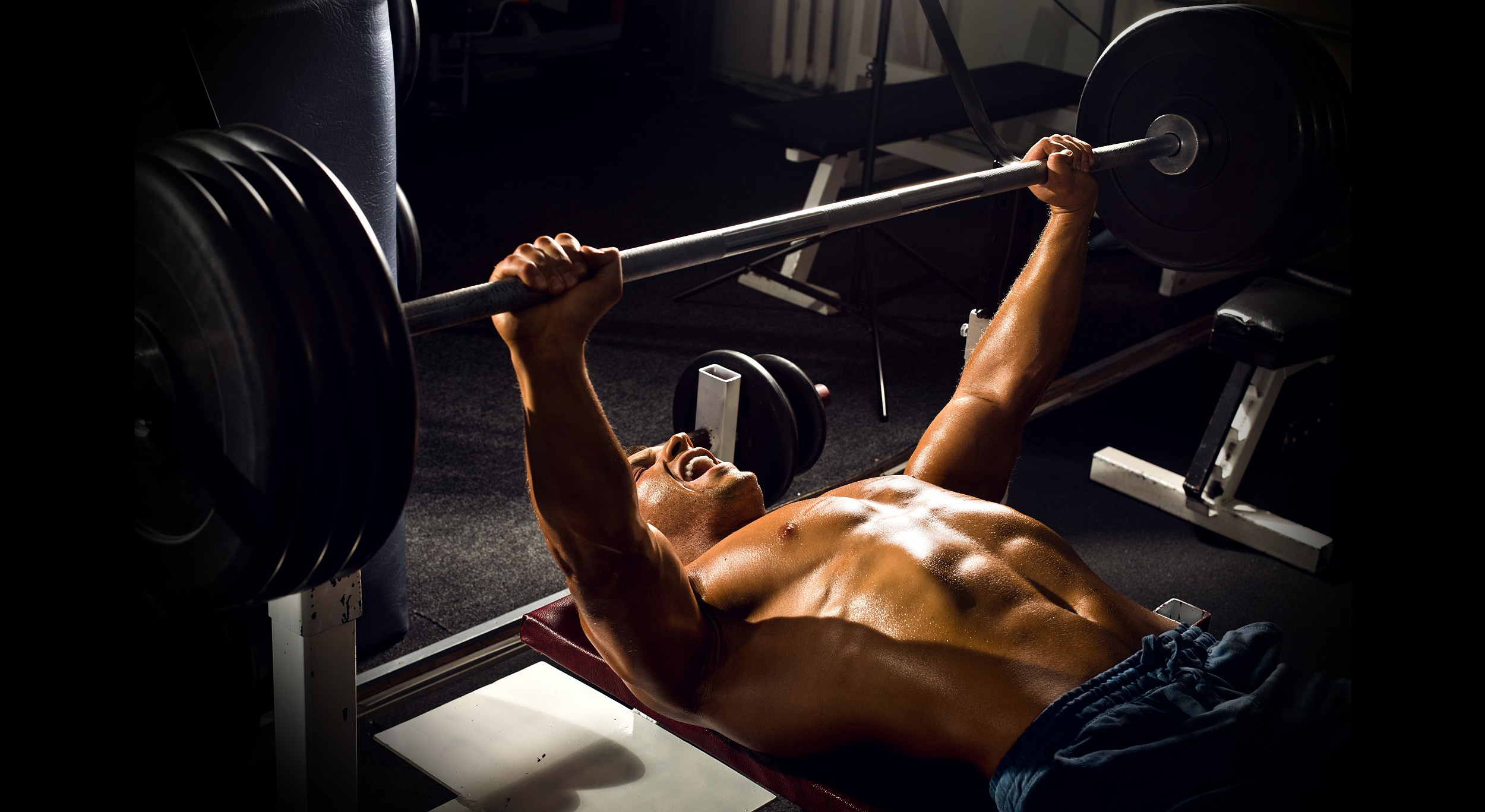The Ultimate Chest Press For Massive Pectorals
Dr. Joel Seedman, Ph.D.
Key Point: Try combining the dumbbell squeeze press with either accommodating resistance in the form of bands or additional adduction forces in the form of various sandwich squeeze press variations. Not only will it blast your chest, shoulders, and triceps but it will also provide a nice boost for your bench press while de-loading your joints.
The dumbbell squeeze press has recently gained quite a bit of popularity in the fitness industry as it provides an effective way to target the chest with more tension. However, another technique that’s recently become more commonplace is the use of accommodating resistance with dumbbell presses typically involving a band behind the back while pressing the weights. Fortunately we can combine both of these methods together and perform a dumbbell squeeze press with accommodating band resistance as I show in this video.
There are five key benefits of this:
1. The squeeze press relies primarily on increased intramuscular tension, constant tension, and metabolic stress to produce a strong hypertrophy stimulus. Unfortunately the top portion of the movement minimizes these mechanisms as it provides a slight rest or relaxation phase for the muscles. That’s because the dumbbells can essentially rest against each other requiring very little work from the pectorals as well as the assisting triceps and shoulders. Adding accommodating resistance solves this issue as the press actually gets more and more difficult the higher you press the weight. In fact the amount of mechanical tension within the chest towards the top half of the movement is difficult to replicate with other isolation movements (i.e. chest flyes), not to mention standard compound movements (i.e. chest presses). As a result the hypertrophy stimulus is incredible.
2. This dumbbell squeeze press with bands not only annihilates the pectorals but it also crushes the triceps and shoulders. In fact, the triceps particularly the lateral head, which is critical for a bigger bench press, gets absolutely hammered in this variation. Try using this exercise for several weeks and watch both your chest growth and bench press numbers significantly increase.
3. Because of the ultra close grip on the squeeze press, this can periodically cause the front deltoids to get slightly inflamed often as a result of excessive elbow flare. Not only does this squeeze press variation force the elbows to stay tight and eliminate elbow flare but it also deloads the bottom position slightly which is where the shoulders tend to get the most banged up during squeeze presses.
4. The squeeze press is typically thought of as a bodybuilding isolation movement. However, when performed with accommodating resistance it actually requires significant neural drive and explosive power to blast through the enormous tension produced from the bands. As a result this squeeze press variation not only isolates the targeted musculature with more constant tension but it also reinforces powerful pressing mechanics and explosive activation of fast twitch muscle fibers. In other words, whether you’re a bodybuilder, powerlifter, or athlete, this exercise will provide numerous benefits.
5. Similar to the above point, this squeeze press not only crushes the chest fibers to a greater degree than standard squeeze presses but it actually requires full body activation to help blast through the sticking point. In fact you’ll notice from the video I’m actually having to engage the glutes and drive with my legs significantly (arguably a bit excessively) to help press the weight up. In other words the squeeze press with band resistance is a full body press while still emphasizing chest growth.
Regressions and Progressions
If you’re unfamiliar with the using accommodating resistance in conjunction with dumbbells I recommend starting with more standard variations (with the dumbbells separated) as demonstrated by one of my NFL athletes Jarius Wynn.
In addition, I would suggest becoming efficient with traditional dumbbell squeeze presses first before adding band tension. Here’s one of my awesome clients Matt Jordan demonstrating a brutal drop set variation of the traditional squeeze press on a slight incline.
Once you’ve mastered all of these variations you can actually isolate the chest further by implementing the anti-fly press protocol with the squeeze press. The main difference between this variation and the accommodating resistance from the bands is that the anti-fly press purely isolates the chest fibers due to the force vectors that are working to abduct the arms and must be resisted throughout. In contrast, the accommodating resistance version with the band around the back involves more vertical force vectors thereby engaging your secondary pressing muscles such as the triceps, shoulders, and lats. Learn more about the anti-fly chest press here.
It should be noted that the accommodating resistance squeeze press variation with the bands does involve a slight anti-fly component. However, it's simply not quite as strong as when the bands or cables are anchored more laterally away from the body such as during the actual anti-fly presses involving significant abduction forces.
Sandwich Squeeze Press
If you really want to get crazy try performing this sandwich squeeze press with a bumper plate as demonstrated by one of my awesome bodybuilding athletes Ben Lai. Just be prepared for a monster burn throughout your entire chest as you’ll be using maximal adduction forces (similar to a maximal contraction at the top of a chest fly) as a means of keeping the weight locked in.
Foam Roller Squeeze Press
Although dumbbell squeeze press is an incredibly effective horizontal pressing movement unfortunately the exaggerated close grip position can oftentimes cause shoulder crowding making it difficult to fully retract and medially rotate the scapula. As a result an exercise that was initially intended to be joint friendly can actually place undue strain on the shoulder joint, elbows, and wrists.
A simple remedy for this is to place a foam roller or medicine ball between the dumbbells as I have NFL players and GSP sponsored athletes Tyson Graham and Christian Blake performing here along with the second video where I perform an incline head off variation.
The foam roller creates just enough space between the dumbbells to promote more natural scapulohumeral rhythm and glenohumeral joint centration thereby optimizing shoulder health and upper body mechanics. This method also provides 3 additional benefits.
1. The lifter actually has to squeeze the dumbbells together more aggressively than a traditional floor press to keep the foam roller from slipping out. As a result the intense adduction forces and maximal isometric chest fly mechanics combined with the horizontal pressing protocol creates enormous intramuscular tension & metabolic stress on the chest not to mention the triceps & shoulders.
2. The lifter is force to slow the squeeze press down even more so than normal to ensure the foam roller doesn’t slip or slide. This eliminates excessive momentum and requires the lifter to use smooth and controlled pressing mechanics.
3. You’ll likely have to reduce the load by 20% on these. However nearly every athlete I’ve had perform these has commented on how intense they were on the targeted musculature particularly the chest. Simply put, this method allows for lighter than normal loading yet still with brutal stimulation to the chest making these a joint-friendly mass builder.
Medicine Ball Squeezing Protocol
Similar to the foam roller squeeze press, this same concept can also be applied using a medicine ball as shown here by several of my NFL and athletes & GSP pros including Julian Williams, Bryce Canady, Marquell Beckwith, and Ike Onike, as well as my awesome figure competitor Leslie Petch. Also huge shoutout to Michelle Siegel at the Sweatboxinc for inspiration for many of these drills. Definitely give her a follow as she’s got some incredible content on her page with very innovative movements and exercises. Also shoutout to Nick Nillson as I believe he’s done the pressing variation of this too.
I want to also note that many of the unique variations you see me and my athletes use make up only 20% of what we do as the other 80% is focused on the basics. With that said, this med ball squeeze protocol has several benefits. First, the level of tension to the entire pectorals is inordinately high not only during the chest press variations but also on every single movement shown here. Even the bicep curls, shoulder raises, pullovers, and tricep skull crushers anghilate the pectorals while also targeting the prime movers of the exercise.
In fact, another unique benefits of this protocol as that the lifter is forced to use smooth and controlled mechanics with little if any momentum in order to ensure they don’t drop the ball. As a result the primary muscles involved for any lifter get absolutely pulverized. For instance, during the bicep curls, even though the chest is getting hammered, the biceps get absolutely decimated due to the high levels of constant tension as smaller ROM the lifter is forced to use.
Lastly I’ve found that the med ball squeezing protocol help reinforce a more optimal ROM. For instance during bicep curls many lifters tend to over-curl at the top. With the med ball variation the lifter will be forced to terminate the movement at the right spot in order to keep control of the ball. Similarly it’s almost impossible to collapse or go excessively deep on the chest presses or pullovers for the same reasons.
Lastly, big shoutout to Kelvin King Jr. who recently showcased a kettlebell fly variation using the same type of accommodating band resistance (with the bands behind the back).
If you really want to blast your chest try super-setting the banded squeeze press with the banded chest fly that he advocates as this will provide an enormous hypertrophy stimulus for the lats.
















































